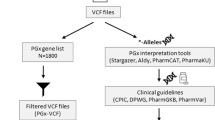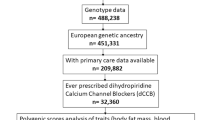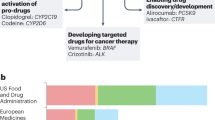Abstract
The information about how DNA sequence varies across the human genome is crucial for unravelling the genetic basis of drug response. A haplotype map, or HapMap, intended to reveal such a variation pattern, has been recently developed by the International HapMap Consortium. Here, we present a conceptual model for directly characterizing specific DNA sequence variants that are responsible for drug response based on the haplotype structure provided by HapMap. Our model is developed in the maximum likelihood context, incorporated by clinically meaningful mathematical functions that model drug response and implemented with the EM algorithm. Our model is employed to a pharmacogenetic study of cardiovascular disease with 107 patients. We found that the haplotype constituted by allele Gly16 (G) at codon 16 and allele Glu27 (G) at codon 27 genotyped within the β2AR candidate gene exhibits a different effect on heart rate curve from the rest haplotypes. Parents with the diplotype consisting of two copies of haplotype GG are more sensitive in heart rate to increasing dosages of dobutamine than those with other haplotypes. This model provides a powerful tool for elucidating the genetic variants of drug response and ultimately designing personalized medications based on each patient's genetic constitution.
This is a preview of subscription content, access via your institution
Access options
Subscribe to this journal
Receive 6 print issues and online access
$259.00 per year
only $43.17 per issue
Buy this article
- Purchase on Springer Link
- Instant access to full article PDF
Prices may be subject to local taxes which are calculated during checkout

Similar content being viewed by others
References
Evans WE, Relling MV . Pharmacogenomics: translating functional genomics intorational therapeutics. Science 1999; 286: 487–491.
Roses AD . Pharmacogenetics and the practice of medicine. Nature 2000; 405: 857–865.
Evans WE, Johnson JA . Pharmacogenomics: the inherited basis for interindividual differences in drug response. Annu Rev Genomics Hum Genet 2001; 2: 9039.
Evans WE, McLeod HL . Pharmacogenomics: drug disposition, drug targets, and side effects. N Engl J Med 2003; 348: 538–549.
Evans WE, Relling MV . Moving towards individulized medicine with pharmacogenomics. Nature 2004; 429: 464–468.
Freeman BD, McLeod HL . Challenges of implementing pharmacogenetics in the critical care environment. Nat Rev Drug Discov 2004; 3: 88–93.
Goldstein DB, Tate SK, Sisodiya SM . Pharmacogenetics goes genomic. Nat Rev Genet 2003; 4: 937–947.
Weinshilboum R . Inheritance and drug response. N Engl J Med 2003; 348: 529–537.
Lynch M, Walsh B . Genetics and Analysis of Quantitative Traits. Sinauer: Sunderland, MA, 1998.
Wu RL, Casella G . Statistical Genetics of Complex Traits: A Quantitative Trait Loci Perspective. Springer: New York, 2005 (in press).
The International HapMap Consortium. The International HapMap Project. Nature 2003; 426: 789–794.
Deloukas P, Bentley D . The HapMap project and its application to genetic studies of drug response. Pharmacogenomics J 2004; 4: 88–90.
The International HapMap Consortium. Integrating ethics and science in the International HapMap Project. Nat Rev Genet 2004; 5: 467–475.
Liu T, Johnson JA, Casella G, Wu RL . Sequencing complex diseases with HapMap. Genetics 2004; 168: 503–511.
Gong Y, Wang ZH, Liu T, Zhao W, Zhu Y, Johnson JA et al. A statistical model for functional mapping of quantitative trait loci regulating drug response. Pharmacogenomics J 2004; 4: 315–321.
Dawson E, Abecasis GR, Bumpstead S, Chen Y, Hunt S, Beare DM et al. A first-generation linkage disequilibrium map of human chromosome 22. Nature 2002; 418: 544–548.
Patil N, Berno AJ, Hinds DA, Barrett WA, Doshi JM, Hacker CR et al. Blocks of limited haplotype diversity revealed by high-resolution scanning of human chromosome 21. Science 2001; 294: 1719–1723.
Gabriel SB, Schaffner SF, Nguyen H, Moore JM, Roy J, Blumenstiel B et al. The structure of haplotype blocks in the human genome. Science 2002; 296: 2225–2229.
Lou X-Y, Casella G, Littell RC, Yang MKC, Johnson JA, Wu RL . A haplotype-based algorithm for multilocus linkage disequilibrium mapping of quantitative trait loci with epistasis in natural populations. Genetics 2003; 163: 1533–1548.
Giraldo J . Empirical models and Hill coefficients. Trends Pharmacol Sci 2003; 24: 63–65.
Zhao W, Wu RL, Ma C-X, Casella G . A fast algorithm for functional mapping of complex traits. Genetics 2004; 167: 2133–2137.
Louis TA . Finding the observed information matrix when using the EM algorithm. J R Stat Soc B 1982; 44: 226–233.
Ranade K, Jorgenson E, Sheu WH, Pei D, Hsiung CA, Chiang F et al. A polymorphism in the beta1 adrenergic receptor is associated with resting heart rate. Am J Hum Genet 2002; 70: 935–942.
Nabel EG . Cardiovascular disease. N Engl J Med 2003; 349: 60–72.
Johnson JA, Terra SG . β-Adrenergic receptor polymorphisms: cardiovascular disease associations and pharmacogenetics. Pharm Res 2002; 19: 1779–1787.
Acknowledgements
This work is supported by an Outstanding Young Investigator Award of the National Natural Science Foundation of China (30128017), a University of Florida Research Opportunity Fund (02050259) and a University of South Florida Biodefense grant (7222061-12) to R W. The publication of this manuscript was approved as Journal Series No. R-10575 by the Florida Agricultural Experiment Station.
Author information
Authors and Affiliations
Corresponding author
Additional information
DUALITY OF INTEREST
None declared.
Rights and permissions
About this article
Cite this article
Lin, M., Aquilante, C., Johnson, J. et al. Sequencing drug response with HapMap. Pharmacogenomics J 5, 149–156 (2005). https://doi.org/10.1038/sj.tpj.6500302
Received:
Revised:
Accepted:
Published:
Issue Date:
DOI: https://doi.org/10.1038/sj.tpj.6500302
Keywords
This article is cited by
-
Pharmacodynamic genome-wide association study identifies new responsive loci for glucocorticoid intervention in asthma
The Pharmacogenomics Journal (2015)
-
A statistical model for the identification of genes governing the incidence of cancer with age
Theoretical Biology and Medical Modelling (2008)
-
Pharmacogenomics and nutrigenomics: synergies and differences
European Journal of Clinical Nutrition (2007)
-
Pharmacogenetics and the concept of individualized medicine
The Pharmacogenomics Journal (2006)



